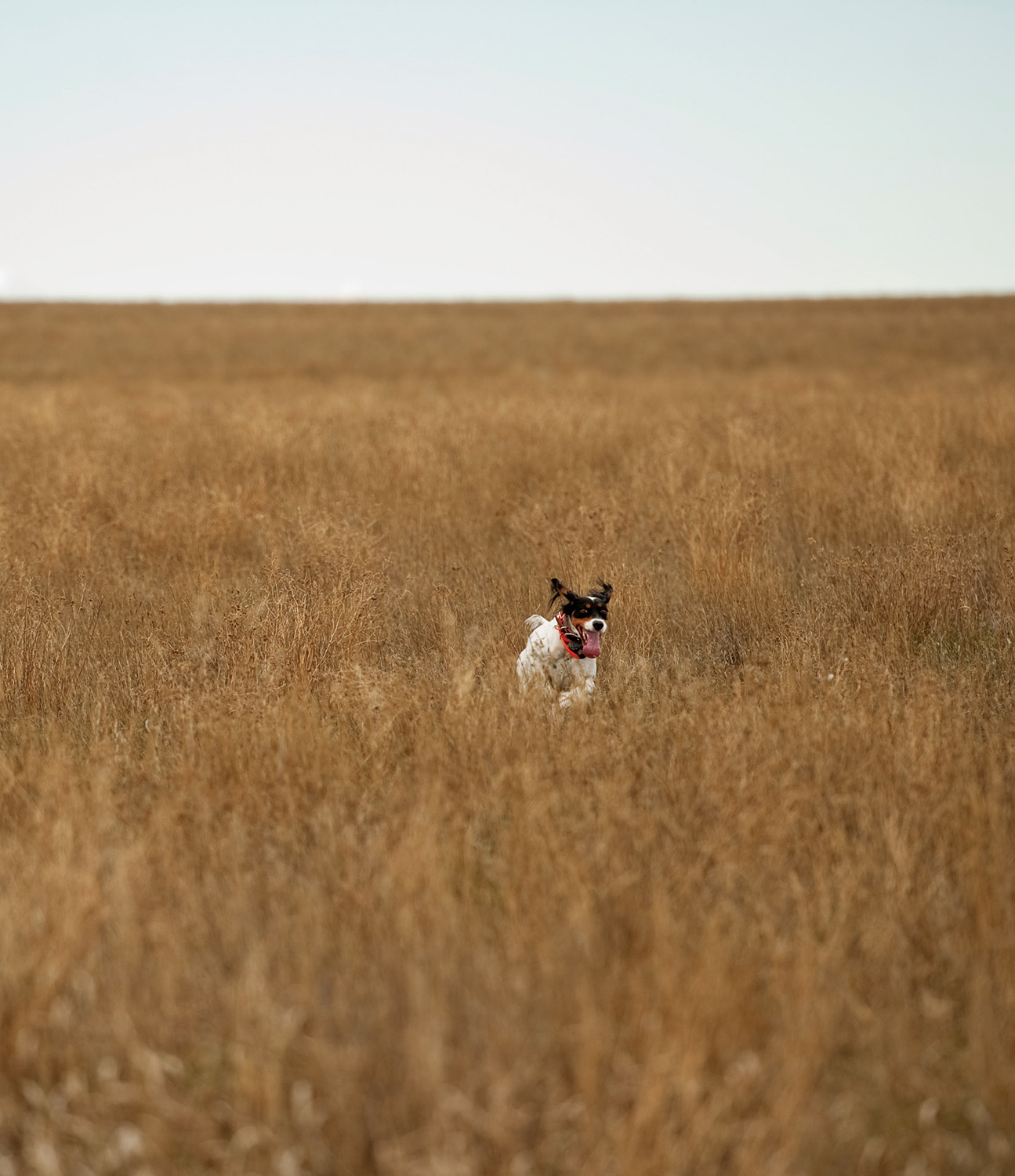
05 Oct Milly Bird the Dog
AS SOON AS SHE’S OFF HER LEASH, Milly Bird the dog darts into the tall grass prairie, a white and black streak against the muted umbers of Montana’s late-August grasses. A blur, until she stops and stands still but for a slight quivering. Her tail lifts, becoming one end of a long, strong arrow, her nose the point. Slowly, she raises a forepaw. Every ounce of her is focused on a bird hidden behind a clump of sagebrush 20 feet or so to the west.
Never mind that Milly Bird the dog — an English setter 3 years old in September — is pointing a chickadee; or that if she wasn’t wearing the orange collar that will bring her back with the slightest of tickles at the throat, she would run a mile or more to pursue the bird when it flutters away. Never mind, too, that in a few short months, my two teenagers and I are meant to be hunting pheasant with Milly as our guide. Good hunting dog or not, at the end of the day, Milly Bird ends up on the couch, her head on a lap, the object of our affections.
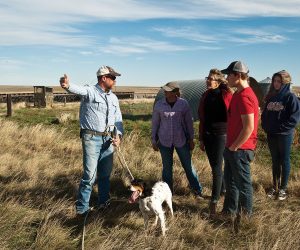
John McIltrot discusses training points with his wife, Michelle Sutton, author Alexis Adams, and the author’s children.
But before we proceed, a caveat: In case it’s not already obvious, I’m a beginner at bird dogs and at hunting birds. This story will be filled with oversimplifications, with inaccuracies, and with misused terminology. It will wander here and there, but it will be true.
After a couple of difficult years — a breast cancer diagnosis followed by divorce, the unmooring that can come with either situation, not to mention one shortly on the heels of the other — I’d spun off from the usual course, moving part-time with my children to the place where I had spent the formative years of my childhood: a remote region on the southern Peloponnese Peninsula in Greece. A rustic, humble place where, were it not for the presence of cell phones, you could easily convince yourself that you’d tripped backward into the post-World War II era of Zorba the Greek. There, in a seaside village of fewer than 300 souls, I crafted a life writing about the region’s culinary history. In the process, I learned to subsist from the land much like our neighbors: gathering wild greens, making cheese and yogurt, curing the wild capers my daughter and I picked along the rocky shoreline, harvesting olives and pressing them into oil, cooking the region’s simple and delicious “blue zone” dishes. For about five years, I ping-ponged back and forth between that village in Greece and our small Montana town. My children were often in tow, unwitting accomplices in my attempt to flee the darkness wrought by cancer and divorce and the place where both stories had played out: Montana, a state I had long loved but suddenly couldn’t bear.
The arrangement worked for a while. Jasper and Sylvie’s father tolerated our travel, even seeing it as good for the children and their perspectives on the world. But as the years passed and they grew older, they began to resist the lifestyle I’d fashioned for them, pleading that we stay put for a while. “Montana is your home too, Mom,” Jasper said once. And he was right. Luckily for me, the timing of their resistance — as is often the case with children — was perfect. I was ready to stop running. I was ready to come home.
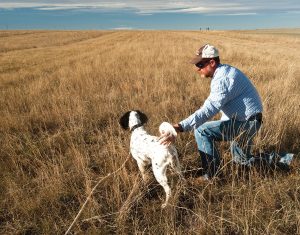
McIltrot works with an English setter named
Mitch, setting him on point.
After the lessons we learned in our little village, it didn’t make sense to subsist on store-bought vegetables, fruits, and meats. After Greece, I was determined to learn the landscape of this place, too, to learn how it could feed us. Their father and I had kept a garden each summer for years. That the children and I would do so again was a given. We could learn some wild edibles. But if we were going to eat meat, it seemed that we would need a gun, likely two, and possibly — in our dreams — a bird dog. But just where and how to begin? I’d never shot a gun, much less worked in tandem with another creature to kill a third creature for supper.
Life sometimes surprises with its serendipities, and this one came a year or so later in the form of John McIltrot, a bird dog trainer and the owner of Seranoa Kennels outside of Broadview, Montana. One mid-November day, the phone rang. I was selling a gas heating stove. The man on the other end of the line told me, in a southern accent, that he was looking for one. We discussed the stove, but when we were done, something kept us talking. Maybe it was the fact that the children were at their father’s for the week and the days outside were short and gray. Maybe it was John’s warm, lilting accent. Whatever it was, somehow the conversation meandered to the subject of bird dogs and hunting. John told me stories about living with his wife, Michelle, on an old homestead in Central Montana, and working with pointing dogs in the field and training them from horseback. I told John I’d just shot my first deer, and that my son and I wished to learn to hunt birds; that someday we might call him to talk about dogs, once we’d saved our pennies. “Well, ma’am,” he replied. “From time to time we end up with a dog whose owner can’t keep him for various reasons, or — worse — doesn’t want to. I reckon if one of those dogs comes our way, you and your children could offer it a good home.”
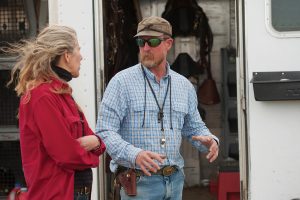
The author and
McIltrot discuss training techniques.
Within a couple of weeks, the phone rang again. “Hello, Lexy,” John said. “Michelle and I have been thinking. We have this dog. She’s a real sweetheart. And we’ve trained her up real good — she’s valuable — but she had an incident with a horse and, as a result, she’s not as comfortable with horses as we’d like her to be. Her name is Milly Bird and she’s a softie. Not meant to be a kennel dog. She’s happiest by the fire. And, well, with your kids and all, and with Christmas being right around the corner, we were thinking, Michelle and I, that you might want to give her a try.”
To fetch Milly, we drove to John and Michelle’s place: a clapboard house and a few outbuildings that sit square against the wind on the wide-open prairie. Milly stole our hearts from the start. We marveled at her nimble athleticism and astonishing speed, her attunement to the proximity of birds, the miracle of watching her stop at the mere inkling of one in hiding, her body on point heeding an instinctive command. That day at John and Michelle’s, we wondered at the way she’d porpoise across the prairie, up and down and up again over sagebrush and through the tall, frost-tipped grasses. We delighted in her joy when, freed momentarily from the instinct to hunt, she saw the children and I from across the field and ran to us, a smile on her beautiful face.
Originally from rural Florida, John fled when the region he called home changed — when the encroaching suburbs turned pastures and wetlands into subdivisions. He is at his best, he says, in wide-open spaces where he can work dogs day in and day out, from before dawn until just before nightfall. A falconer since age 16, John, now in his 40s, almost looks like a bird of prey, with slightly rounded shoulders and eyes intense and focused. He hunts prairie grouse with a captive-bred gyrfalcon. His interest in falconry led him to pointing dogs and horseback field trialing 30-some years ago. He got hooked, he says. So when Florida “became too small” he moved to Montana to set up Seranoa Kennels. During a trip back some years ago, he fell in love with Michelle, and eventually she moved to Montana too. Now they work together, teaching the dogs to run a strong forward pattern, to turn with the handler, to find and hold birds, to be steady to wing and shot. Michelle modestly calls herself John’s assistant, and works quietly beside him. They don’t need to speak much, she says. They know the language of each other’s hand gestures, each other’s glances.
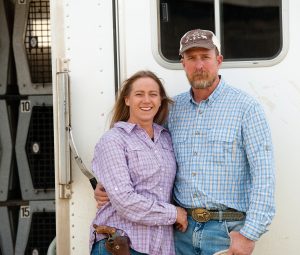
Michelle Sutton and John McIltrot of Seranoa Kennels.
Theirs is a new vocabulary for us. We are greenhorns, but we are slowly learning. We visit Seranoa Kennels often. There, John and Michelle help Milly unlearn the bad habits we’ve taught her since our last visit, and teach us to work with her on the good. All three of them are generous, even as we fumble.
Walking with John in the field humbles me. To bid a dog to come, he drops to one knee and holds up a hand. That’s all it takes for the dog to come running. When he does use voice commands, they are always delivered in a hushed tone. When he whistles, he whistles softly. When he trains a young dog, he sets him or her up on point again and again, always gently. Trust is everything with dogs, he tells me, as is repetition. For John and Michelle, it’s not a matter of patience with dogs or horses or falcons, or teenagers for that matter, for patience implies a certain inadequacy in the other. Neither John nor Michelle sees dogs as inadequate. They see them as mishandled, as misbred, as perfect creatures somehow screwed up by the hand of man.
“We’ve both learned that helping people is as much a part of our job as helping dogs,” John says. “Anymore, that’s what I work hardest at. It doesn’t do any good to bring a dog well along and hand him back to someone who doesn’t understand him. The dog deteriorates. The folks who find us really do want to learn.”
While I know John means the folks who find them want to learn the language of dogs, I’ve come to understand that he and Michelle also use dogs to help people find a scrap of silence, maybe even solace, in a clamoring world. There’s nothing like working with Milly in the big wide-open to ease the mind’s chatter.
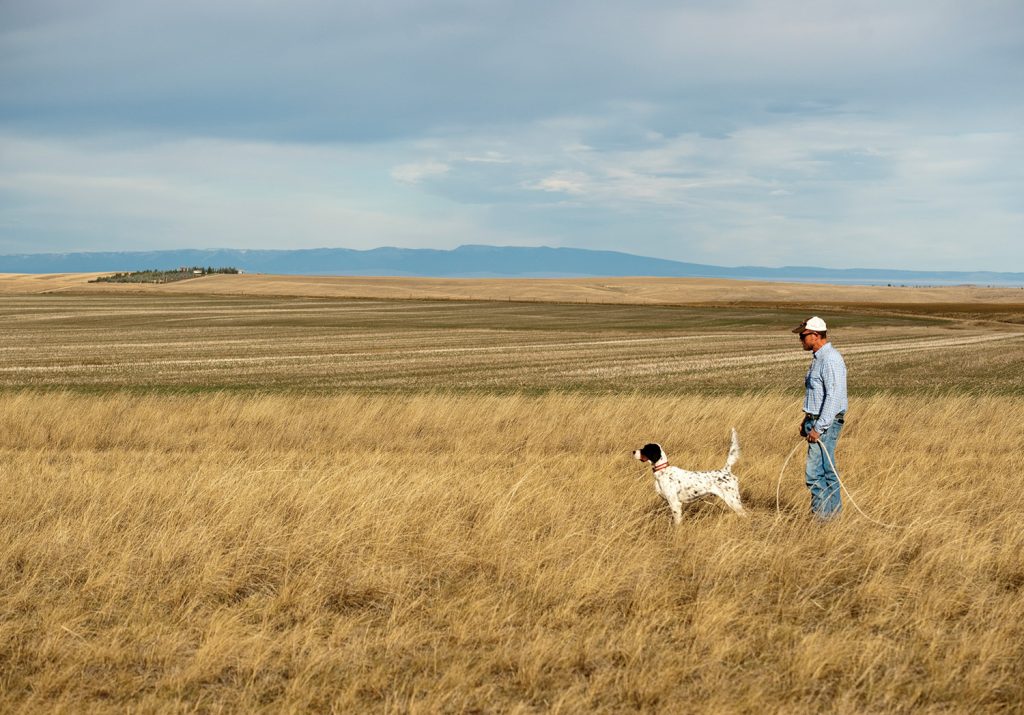 McIltrot and Milly Bird the dog work in the field outside of Broadview, Montana.
McIltrot and Milly Bird the dog work in the field outside of Broadview, Montana.
“I think a lot of the reason I started doing this has to do with my own frailty,” says John. “In a way, for me, a bird dog is a barrier against all the stuff out there in the world that I’d rather not know about: the ugliness and greed and violence. Things that dogs don’t know about. When you’re spending time with a dog, they’re present. They’re here and now. Somebody from back home recently asked me if Michelle and I were hiding up here in Montana. I guess in a way we are. We decided to change the channel on life. We decided to distance ourselves from the modern world. What we learn from dogs and the natural world is a thousand times more meaningful than all the pollution out there.”
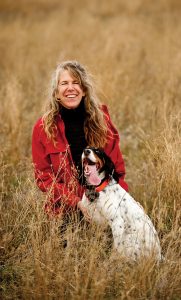
The author
and Milly Bird.
It’s a warm fall afternoon about a year after Milly Bird the dog came to us, and I am helping Jasper dry-pluck his first pheasant — one he shot with Milly pointing the way. As we pluck, I marvel at the bird’s feathers, their burnished colors, like October’s grasses and leaves, and I think of John and Michelle who, really, are the reason we hold this creature, this feast, in our hands. I recall their generosity and I’m grateful they decided to “change the channel on life” and come to Montana. I am thinking it is about time for another visit their way. And anyway, I’ll admit, despite the beauty of the fall, I’ve lately been missing Greece. Visiting the kennel always helps me reset. It does wonders for the kids, too. There, they put away their electronic devices and ride horses, play with the dogs, engage.
And then, as I’m plucking, it dawns on me that a day with John and Michelle and their dogs is a little bit like a day in that seaside village. In both places, life is simple, fairly predictable, and pared to the essentials. Certainly, things happen, things go wrong. But life continues, mostly unchanged. In Greece, even with its economic crisis, the olives still get picked and pressed, the grapes grown and turned to wine, and in Central Montana, there are dogs and humans to teach, horses to ride, poetry to read. And maybe there’s a lesson in that: boil life down to the basics. Turn off the Wi-Fi. Put down the phone. Go for a walk with your bird dog, ideally in a great big wild place where there’s a whiff of sagebrush. Better yet, with a dog who manages to point a pheasant rather than a chickadee. Just as Milly Bird the dog did earlier this week.




No Comments